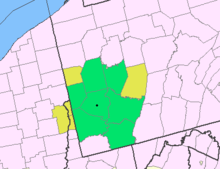Linn Run State Park
The Byers and Allen Lumber Company clear cut the forest that is now Linn Run State Park in the 1890s.
Steam locomotives of the Pittsburgh, Westmoreland and Somerset Railroad passing through would ignite this dry brush, causing massive wildfires that swept through the mountains and valleys.
[3] In his first report in 1909, Forester John R. Williams wrote, "I should say that fully three-fifths (60%) of the reserve had been burned since the lumbering was done.
[3] During the New Deal era, the park was further developed by the Civilian Conservation Corps and Works Progress Administration.
Ten rustic cabins, stone fireplaces, and several buildings and bridges were constructed, along with roads, water and sewage systems, and utilities.
[4][5] Today, the area in and around Linn Run State Park is now a thriving second growth forest.
[6] Hunting is permitted on about 400 acres (160 ha) of Linn Run State Park.
[6] Linn Run State Park has long been a popular destination for families and church groups for picnicking.
The older cabins, dating back to 1933, were constructed by the Civilian Conservation Corps during the Great Depression in an architectural style known as WPA Rustic.




